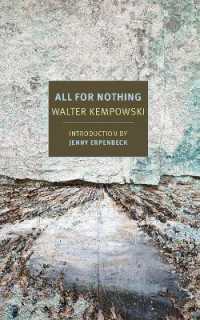Full Description
The evidence presented in this book suggests that when the necessary conditions for disaster risk reduction (DRR) are in place, it is possible for elected officials to pursue DRR policies in their rational self-interest. As such, when the media makes it possible through lesson-drawing coverage of distant disasters, DRR policies become much more likely in observing communities because elected officials can seize the opportunity to both make political gains and protect their constituents. Authors Thomas Jamieson and Douglas A. Van Belle provide reasons for optimism about the prospect of DRR in at-risk communities around the world—observing communities are able to learn from the experiences of stricken areas and pursue policies that ultimately save lives and reduce economic damage from disasters.
In That Could Be Us, Jamieson and Van Belle find that the news media delivers information to observing communities in a form that enables learning from other disasters. Experimental evidence shows that people react to this information in a way that would punish leaders who do not back DRR efforts. Case studies, interviews, experiments, and illustrative examples suggest that leaders and political entrepreneurs heed this public demand, react to news media coverage, and act accordingly. Taken as a whole, this suggests that the policy and research implications derived from this book's theoretical model are worthy of further exploration, particularly in terms of how they might resolve the puzzle presented by the variations in DRR policy uptake around the world that do not seem to be driven by developmental differences across communities.
Contents
List of Figures
List of Tables
Preface
1. Introduction
Existing Approaches to Disaster Risk Reduction
Implications of the Third-Person Effect Model
Structure of Enquiry and Presentation
2. The Third-Person Effect Model
Disasters and Response Exhaustion
Prospect Theory and the Recouping of Losses
Sufficient Versus Necessary Causes
Media and the Public Will to Act
The Third-Person Effect
News Media, Audiences and Localization
Rational Political Leaders and the Political Will to Act
The Full Third-Person Effect Model
Media Engagement and the Creation of Opportunities for Disaster Risk
Reduction
Framing, Prospect Theory and the Overvaluing of Held Assets
Implications of Opportunism and the Pursuit of Universalism
Discussion
3. How News Media Set the Agenda: A Taxonomy of Localization
Localization and News Production
Analytical Approach
Case Selection
Process of Analysis
A Taxonomy of Localization
Communalization
Neutral Localization
Othering
Discussion
4. DRR on the Public Agenda: How Development Affects News Coverage
Is Localization as Common as Believed?
Patterns of Communalization and Othering
Extending the Analysis: Development and Localization
Materials and Methods
Results
Discussion
5. The Public Will to Act: The Effect of News Coverage on Public Opinion
Policy Learning
Democratic Responsiveness and Policy Learning
The News Media and Policy Learning
Public Opinion and Policy Learning
Localization and the Public Agenda - Theory and Hypotheses
Experimental Design
Results
Discussion
Conclusion
6. The Political Will to Act: Mandatory Retrofitting Ordinances in Los Angeles
Materials and Methods
Structure of Presentation
Public Will to Act
Political Will to Act
Discussion
Conclusion
7. Beyond Plausibility: When the Media Makes it Possible
The Plausibility of the Third-Person Effect Model
Opportunities for DRR Adoption
Which Events Create Opportunities for DRR?
The Political and Conceptual Logic of Necessary Conditions
Beyond DRR Policy
8. Epilogue
Appendix 1
Appendix 1A. Gathering the Newspaper articles.
Appendix 1B. Taxonomy of Localization
Appendix 1C. Coding Scheme
Appendix 1D. Intercoder Reliability Tests.
Appendix 2
Appendix 2A. The Full Experimental Design
Appendix 2B. Comparisons between the Survey Sample and the Californian
Population
Appendix 2C. Willingness to Accept Costs of DRR
Appendix 3
Appendix 3A. Focal Questions for Interviews
Appendix 3B. Recruitment Email for Interview Participants
References







